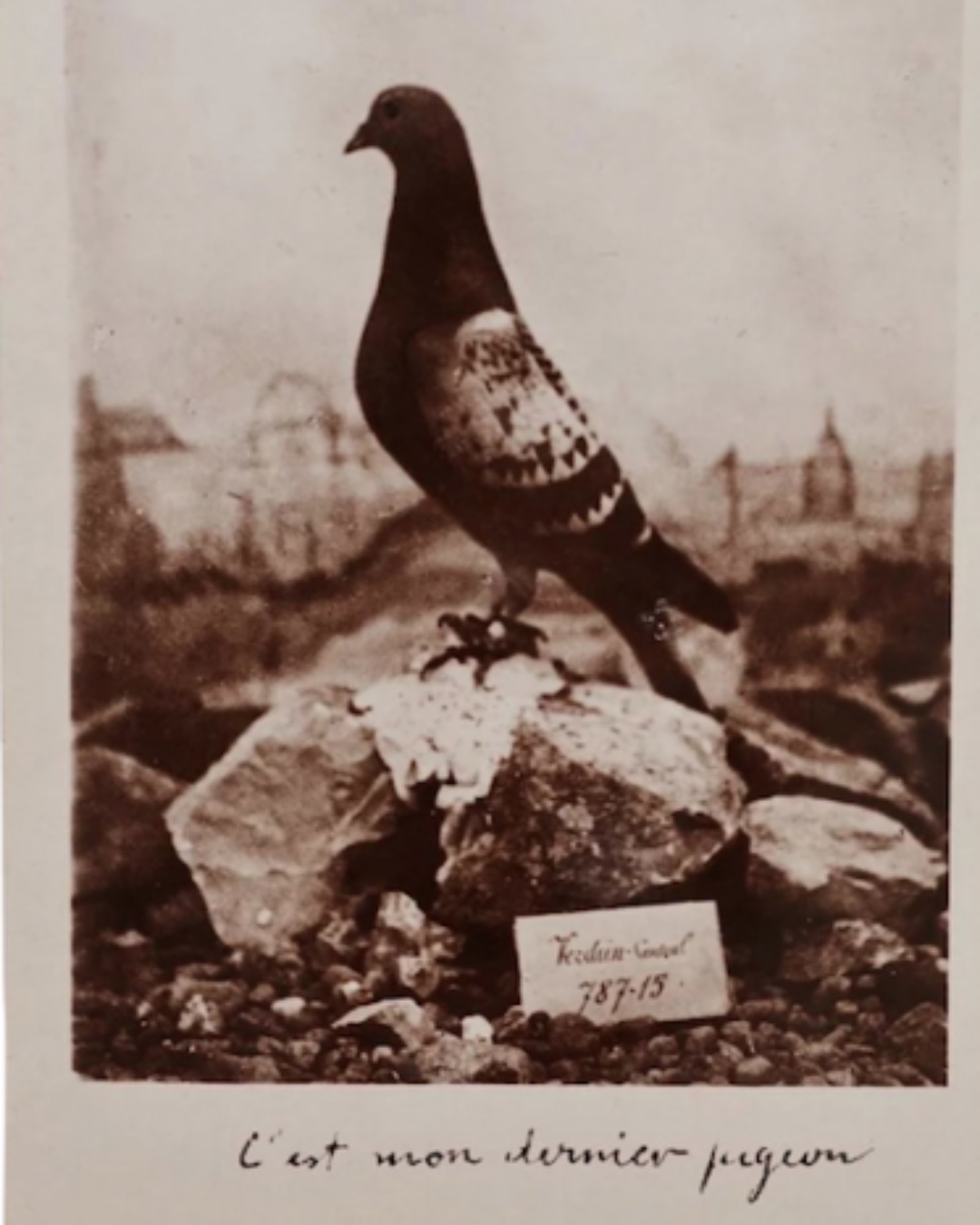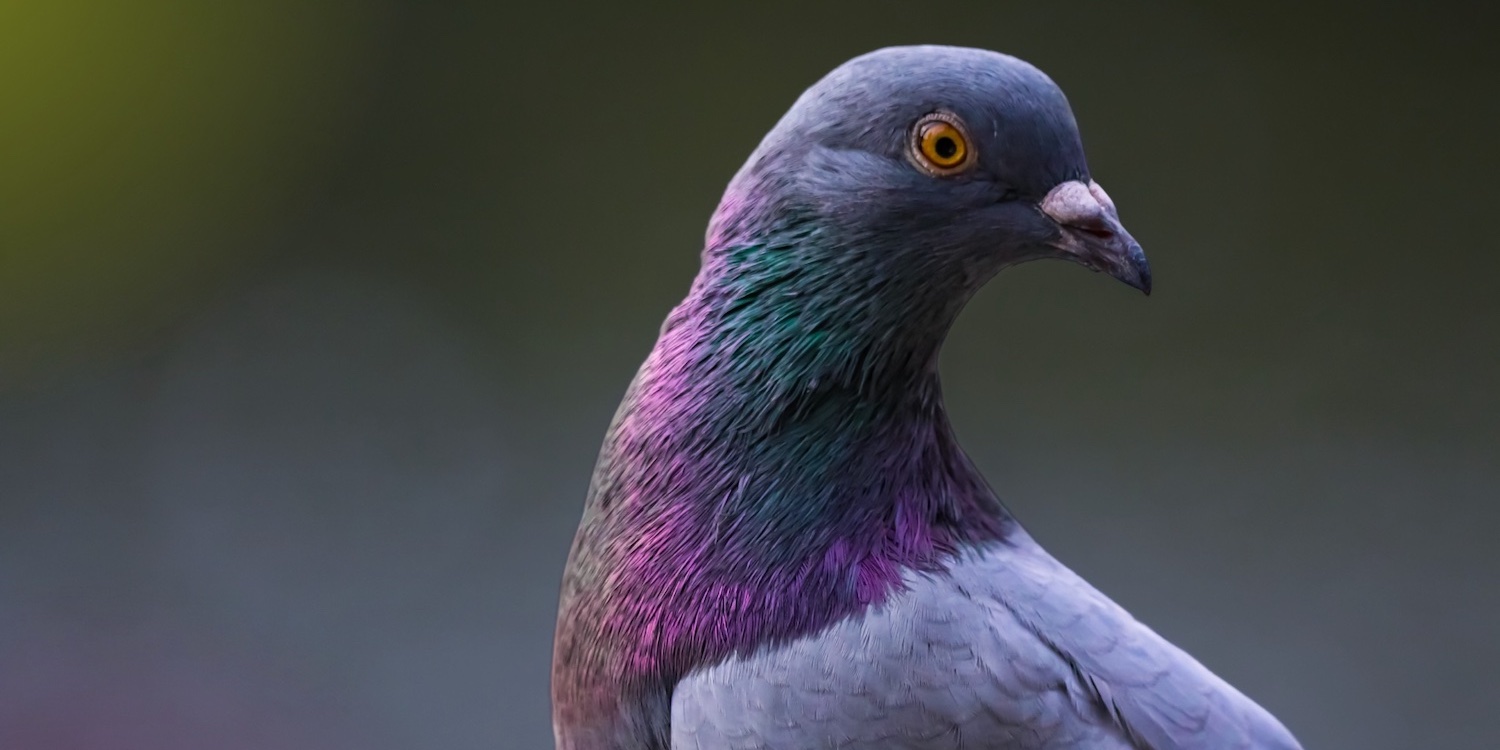[ad_1]
Ubiquitous in our cities, pigeons are often overlooked despite their fascinating behaviors. One lesser-known aspect of their behavior is monogamy: Pigeons are monogamous and mate for life, although this monogamy is more social than genetic. Indeed, infidelities have been found to occur among pigeons, even if they are rare.1
In urban areas, pigeons nest in building cavities. The female typically lays two eggs, incubated by the male during the day and by the female at night. The parents then feed the chicks with “pigeon milk,” a nutritious substance produced in their crop2. After about a month, the young pigeons begin to fly and leave the nest a week later. A pair of pigeons can thus raise up to six broods per year.3
Despite difficult accounting, it is estimated that around 11 million equines and tens of thousands of dogs and pigeons were used during the First World War4. Carrier pigeons were particularly valuable in the past for delivering urgent and secret messages. For example, pigeons were used by the French army to communicate on the front lines.
Before the war, military pigeon training centers had been established in France, at Coëtquidan and Montoire. During the war, these pigeons were transported in mobile field units, often in specially equipped trucks, and were sometimes launched from planes or ships.5 About 60,000 pigeons were mobilized for the First World War.6
Among these heroic pigeons, history has remembered Vaillant. Pigeon Vaillant is considered a hero of the First World War. Registered as 787.15, Vaillant was the last pigeon from Fort Vaux (a strategic location for the French army), released on June 4, 1916, to deliver a crucial message from Commander Raynal to Verdun. This message, transported through toxic fumes and enemy fire, reported a gas attack and called for urgent communication. Gravely poisoned, Vaillant arrived dying at the pigeon loft of the Verdun citadel, but his message saved many lives. In recognition of his heroic act, he was cited in the National Order: a French decoration recognizing services or acts of exceptional devotion, accomplished for France at the risk of one’s life.7

A vintage postcard depicting a carrier pigeon. (Source)
Today, the management of pigeon populations varies considerably from one city to another. In France, there is no specific legislation governing this management, leaving municipalities that wish to intervene free to choose between cruel methods (such as shooting, capture followed by gassing, surgical sterilization, or scaring) or ethical methods like contraceptive lofts (structures that provide a habitat for pigeons while controlling their population). Methods of population control involve shaking laid eggs, replacing them with fake ones, and providing contraceptive corn (a contraceptive treatment that specifically targets pigeons, presented in the form of corn kernels). This new method, respectful of animal welfare, has already proven its effectiveness in many European cities.8
To better understand current practices, Projet Animaux Zoopolis (PAZ) asked for administrative documents related to pigeon management from nearly 250 municipalities (the largest in France in terms of population). The current results show that about one in two cities uses cruel methods.
To combat these practices, PAZ acts at both local and national levels. At the local level, the association conducts investigations to highlight the cruel methods used by certain cities, supports reports through petitions, and meets with elected officials to present ethical and effective methods. Thanks to our efforts, several cities have stopped using cruel methods against pigeons, such as Annecy, Colmar, Marseille, Nantes, Rennes, and Tours.
At the national level, PAZ has succeeded in raising political awareness about the cruel methods employed against pigeons. Since the beginning of the campaign, 17 deputies and senators have submitted written questions to the Government, and a bill aimed at legislating on this issue is being prepared.
PAZ is also committed culturally to promoting peaceful coexistence with liminal animals, which are animals that live freely in urban spaces. These animals, including pigeons, rats, and rabbits, are impacted by urbanization, including disturbances in habitat, lifestyle, and diet. The association strives to spark public debate on the management of pigeons. In 2023, our actions to defend pigeons garnered over 200 media responses, and since early 2024, we have counted more than 120.
In 2024, PAZ initiated the first World Day for the Defense of Liminal Animals, focusing on pigeons and cruel methods of targeting them. This day is supported by 35 associations, three political parties, and two municipalities in France. Fifteen street mobilizations are planned worldwide, including 12 in Europe and three in the United States. Other cultural influence actions (e.g., articles, podcasts, etc.) will also take place in Spain, Italy, Mexico, and France.
It is crucial to care about the fate of pigeons and other liminal animals9 who are despised or even killed. Although it’s difficult to estimate the number of pigeons in France precisely, we know that there are about 23,000 rock pigeons (Columba livia) in Paris.10 Cruel management methods, such as shooting, gassing (similar to drowning), scaring (where pigeons are subjected to predation by birds of prey that themselves have had to endure training and captivity), and surgical sterilization (a painful method with a very high mortality rate), cause great suffering for many individuals. There are pigeons in every city. PAZ is fighting for significant progress by highlighting the horror of these management methods, their inefficiency, the growing public empathy for pigeons, and the availability of ethical and effective alternatives.
-
Patel, K. K., & Siegel, C. (2005). Research Article: Genetic monogamy in captive pigeons (Columba livia) assessed by DNA fingerprinting. BIOS, 76(2), 97–101. https://doi.org/10.1893/0005-3155(2005)076[0097:ragmic]2.0.co;2
-
Horseman, N. D., & Buntin, J. D. (1995). Regulation of pigeon cropmilk secretion and parental behaviors by prolactin. Annual Review of Nutrition, 15(1), 213–238. https://doi.org/10.1146/annurev.nu.15.070195.001241
-
Terres, J. K. (1980). The Audubon Society Encyclopedia of North American Birds. Knopf.
-
Baratay, E. (2014, May 27). La Grande Guerre des Animaux. CNRS Le Journal. https://lejournal.cnrs.fr/billets/la-grande-guerre-des-animaux
-
Chemins de Mémoire. (n.d.). Vaillant et ses pairs. https://www.cheminsdememoire.gouv.fr/fr/vaillant-et-ses-pairs
-
Archives Départmentales et Patrimoine du Cher. (n.d.) Pigeons voyageurs. https://www.archives18.fr/espace-culturel-et-pedagogique/expositions-virtuelles/premiere-guerre-mondiale/les-animaux-dans-la-grande-guerre/pigeons-voyageurs
-
Jean-Christophe Dupuis-Remond. (2016, July 6.) Histoires 14-18: Le Valliantm le dernier pigeon du commandant Raynal. FranceInfo. https://france3-regions.francetvinfo.fr/grand-est/meuse/histoires-14-18-vaillant-le-dernier-pigeon-du-commandant-raynal-1017569.html; Derez, J.M. (2016). Le pigeon Vaillant, héros de Verdun. Éditions Pierre de Taillac.
-
González-Crespo C, & Lavín, S. (2022). Use of fertility control (Nicarbazin) in Barcelona: An effective yet respectful method towards animal welfare for the management of conflictive feral pigeon colonies. Animals,12, 856. https://doi.org/10.3390/ani12070856
-
Liminal animals are defined as animals that live freely in urban spaces, such as pigeons, sparrows, and rats. Often despised or even killed, they are greatly impacted by urbanization.
-
Mairie de Paris. (2019.) Communication sur la stratégie « Pigeons ». https://a06-v7.apps.paris.fr/a06/jsp/site/plugins/odjcp/DoDownload.jsp?id_entite=50391&id_type_entite=6
[ad_2]
